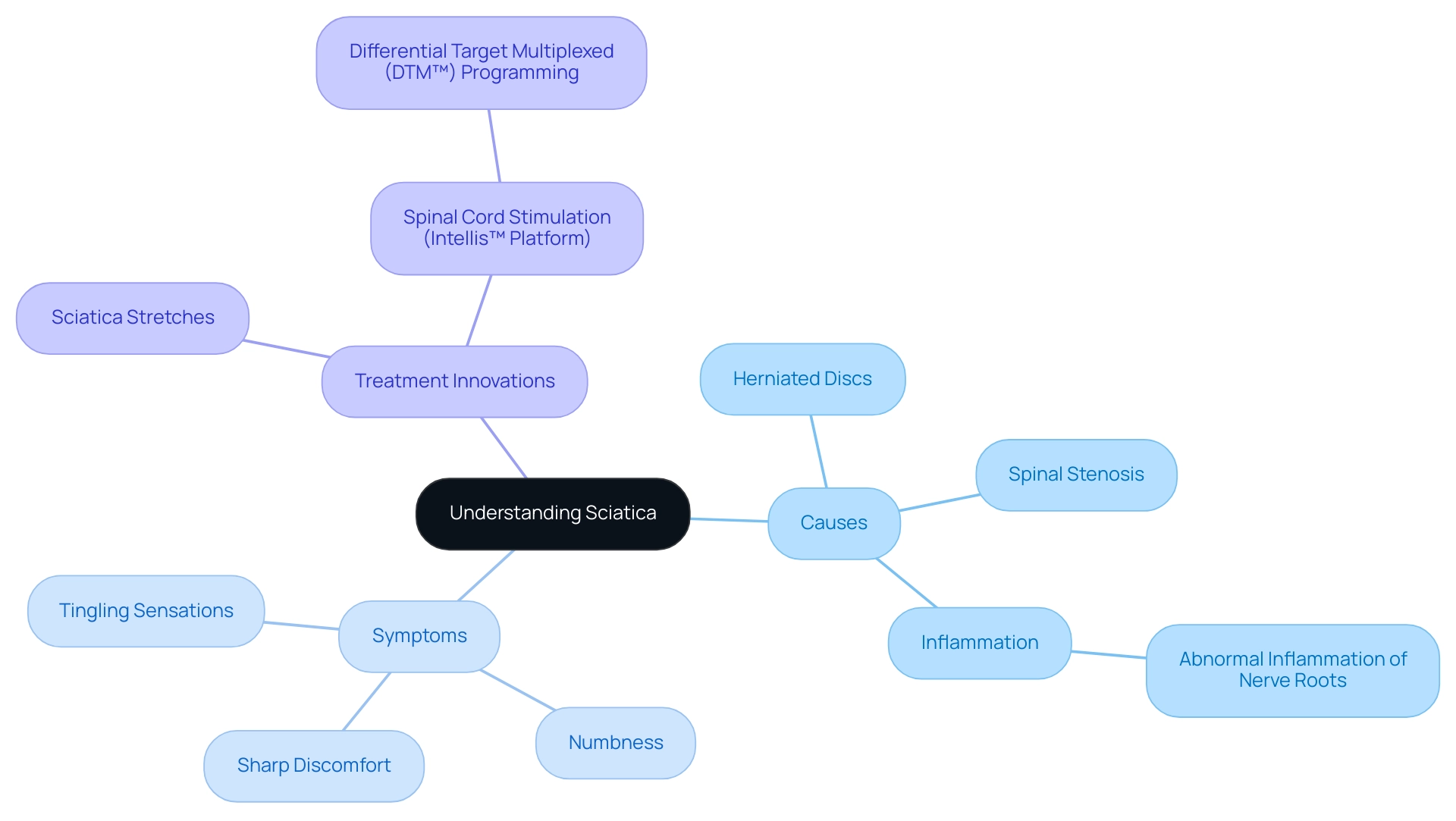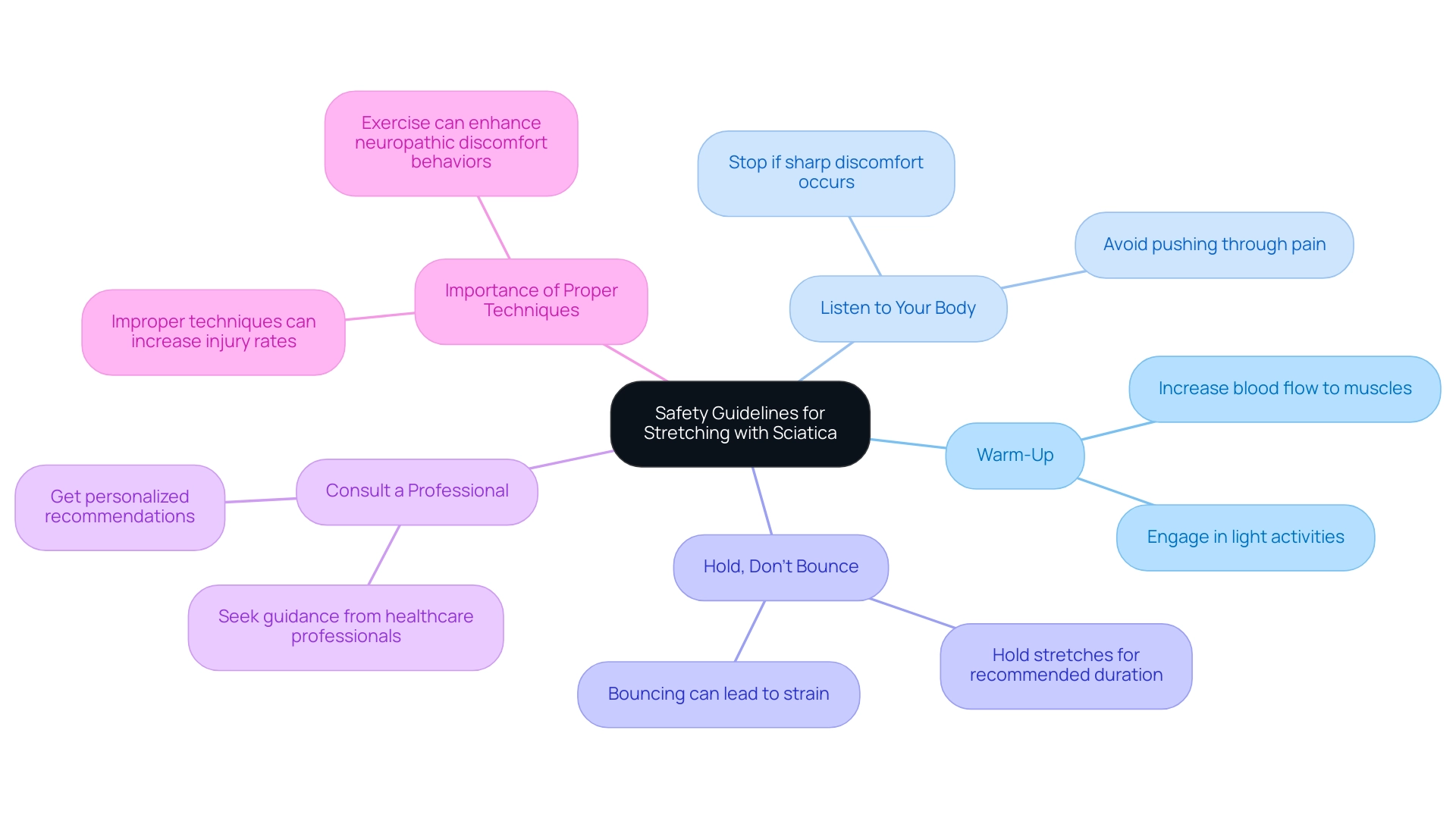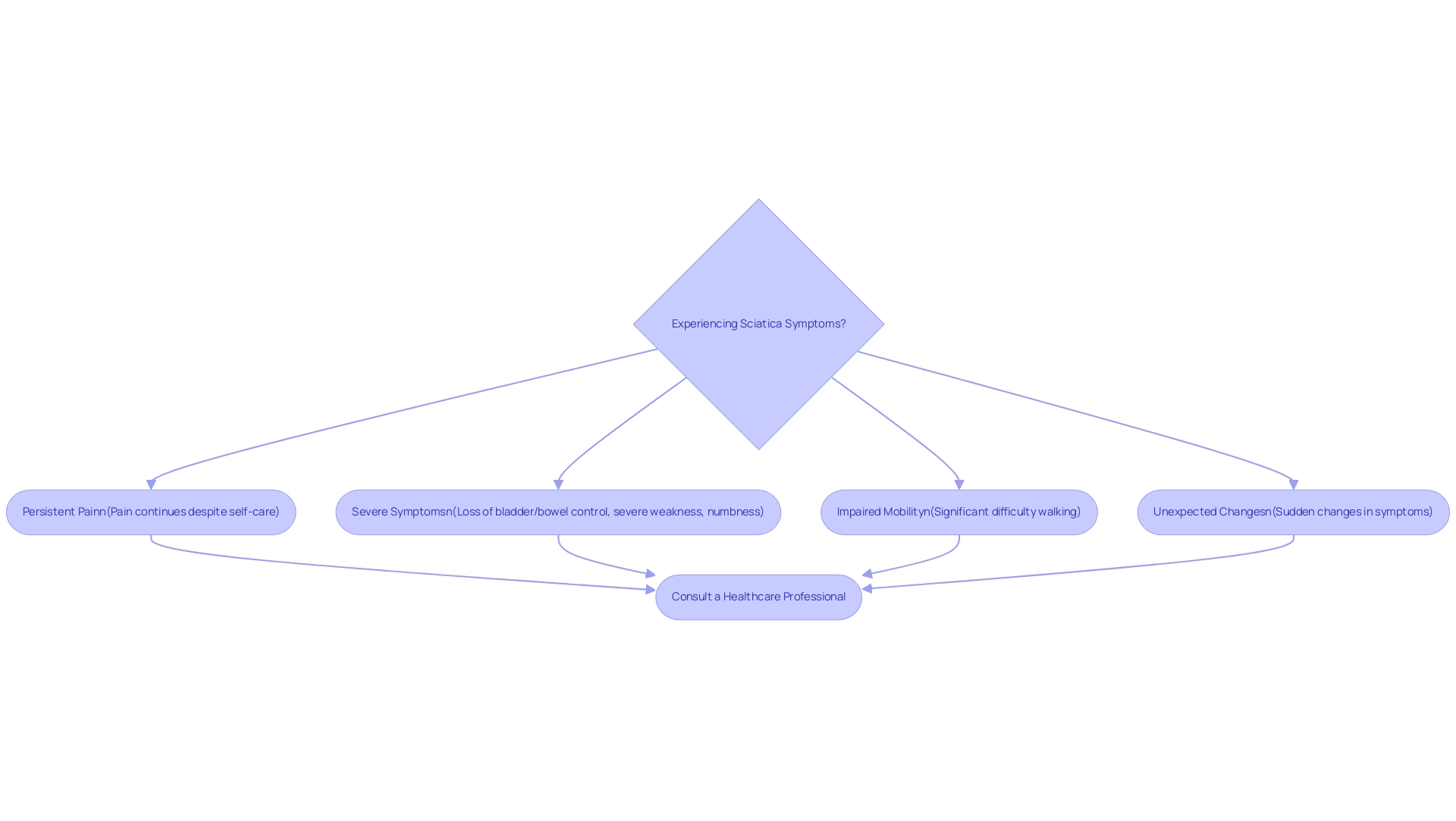Introduction
Sciatica, a condition characterized by pain radiating along the sciatic nerve, affects countless individuals, often leading to significant discomfort and mobility challenges. The origins of this condition can be varied, ranging from herniated discs to spinal stenosis, and understanding the symptoms is key to effective management.
As research continues to unveil insights into sciatica's prevalence and its association with lifestyle factors, it becomes increasingly important to explore targeted relief strategies. This article delves into the causes and symptoms of sciatica, outlines essential stretches for immediate relief, and emphasizes safety guidelines for effective stretching.
Additionally, it highlights the long-term benefits of regular stretching and offers advice on when to seek professional help, providing a comprehensive resource for those affected by this debilitating condition.
1. Understanding Sciatica: Causes and Symptoms
Sciatica is a condition characterized by discomfort that radiates along the sciatic nerve, which extends from the lower back, through the hips and buttocks, and down each leg. This discomfort can arise from various underlying issues, such as herniated discs, spinal stenosis, or
abnormal inflammation affecting the nerve roots, which can lead to significant swelling. Common symptoms include sharp discomfort, numbness, and tingling sensations in the affected leg.
These symptoms often worsen with prolonged sitting or standing. Recent studies have illuminated the prevalence of this condition, revealing that living alone is negatively associated with it, reflected in an odds ratio of 0.81. Furthermore, results for individuals with nerve-related issues differ, with chronic discomfort patients typically facing worse results after surgery compared to those with short-term discomfort.
Understanding these symptoms and their causes is crucial for seeking appropriate relief methods. In particular, sciatica stretches have shown promise in alleviating discomfort and enhancing mobility. Additionally, a case study titled 'Association of Multisite Pain with Sciatica' discovered that multisite pain exhibited the strongest connection with this condition compared to other factors, indicating important implications for clinical practices in treating patients.
Medtronic's recent innovations in spinal cord stimulation therapy, notably the Intellis™ Platform with Differential Target Multiplexed (DTM™) programming, highlight the ongoing advancements in treatment options available for managing sciatica effectively.
2. 7 Essential Stretches for Immediate Sciatica Relief
-
Piriformis Stretch: Begin by lying on your back with your knees bent. Cross the affected leg over the opposite knee, then gently pull the uncrossed knee towards your chest. Hold this position for 20 to 30 seconds to relieve tension in the piriformis muscle, which can often be addressed with sciatica stretches to alleviate sciatic discomfort. This stretch aligns with findings from Avila L et al., who highlight the effectiveness of cognitive functional therapy in managing pain through targeted exercises.
-
Knee to Chest Stretch: While lying on your surface, draw one knee towards your chest, holding the position for 20 to 30 seconds. This stretch aids in loosening the lower spine and alleviating discomfort related to sciatica stretches. Repeat the process with the other leg. Studies, such as Weber et al. (1983), indicate that participants averaging 41.7 years old often benefit from such stretches.
-
Seated Forward Bend: Sit with your legs extended straight in front of you. Lean forward towards your toes while maintaining a straight posture. Hold this stretch for 20 to 30 seconds to effectively elongate the spine and hamstrings; these sciatica stretches can provide relief to sciatica symptoms.
-
Child’s Pose: Kneel on the floor and sit down on your heels. Stretch your arms forward on the ground, lowering your torso towards the floor. Maintain this stance for 30 seconds, as it encourages relaxation and alleviates tension in the lower region and hips.
-
Figure Four Stretch: Lie on your spine and cross one ankle over the opposite knee, forming a figure four shape. Gently pull the uncrossed leg towards you, holding for 20 to 30 seconds. This stretch targets the hips and glutes, which are often involved in
sciatica discomfort and can be relieved with sciatica stretches. Evidence from high-quality studies indicates that slump stretching can enhance disability in patients with lower lumbar discomfort, offering real-world support for the efficacy of such stretches.
-
Cat-Cow Stretch: Position yourself on all fours. Alternate between arching your spine upwards (cat) and lowering your belly towards the ground (cow). Continue this dynamic movement for 30 seconds to improve flexibility in the spine and relieve tension in the back.
-
Hamstring Stretch: Sit with one leg extended straight and the other bent. Reach towards the extended leg, holding the stretch for 20 to 30 seconds. This exercise aids in alleviating tightness in the hamstrings, which can lead to discomfort in the lower back and nerve issues. Repeat on the other side.
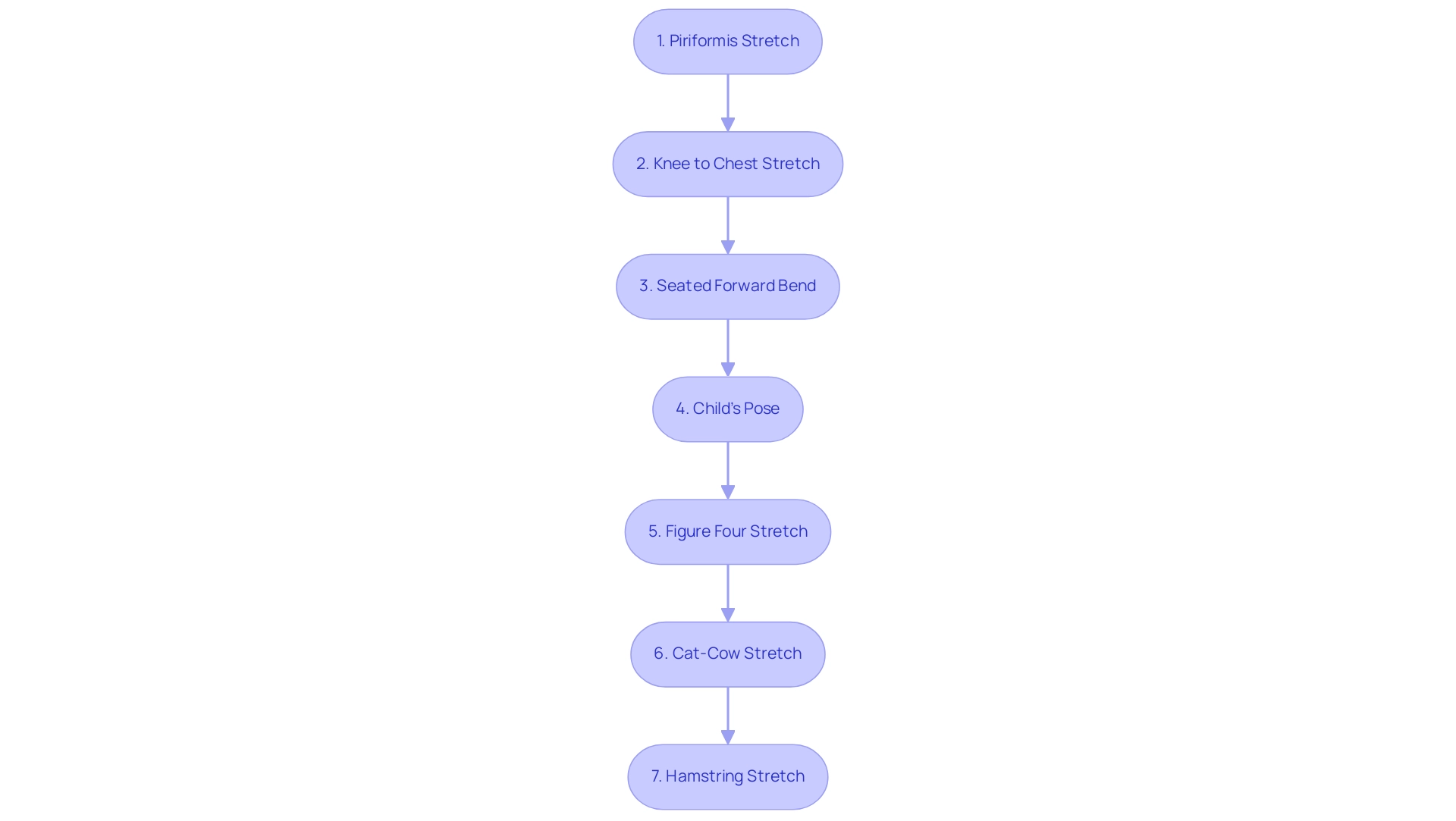
3. Safety First: Guidelines for Stretching with Sciatica
When performing sciatica stretches, it is essential to adhere to the following guidelines to ensure safety and effectiveness:
-
Warm-Up: Engaging in light activities such as walking or gentle cycling is crucial before doing sciatica stretches. A proper warm-up increases blood flow to muscles, reducing the risk of injury.
-
Listen to Your Body: Pay close attention to your body’s signals. If any stretch induces sharp or significant discomfort, it is important to stop immediately and refrain from pushing through it.
-
Hold, Don’t Bounce: Each stretch should be held for the recommended duration without bouncing. Bouncing can lead to strain and exacerbate pain, undermining the benefits of stretching.
-
Consult a Professional: If there is any uncertainty regarding the correctness of a stretch or if pain persists, it is advisable to seek guidance from a healthcare professional or a physical therapist. Their expertise can provide personalized recommendations tailored to individual needs, including sciatica stretches, which not only help in alleviating symptoms but also play a vital role in preventing further injury, especially since improper stretching techniques can lead to increased injury rates.
Studies indicate that
cure rates for sciatica vary significantly, with some reports suggesting over 75% while others indicate less than 50%, underscoring the importance of proper techniques. Shunxin Liu observes that 'the duration of postoperative exercise plays a crucial role in the onset of exercise-induced hypoalgesia,' emphasizing the essential nature of exercise in managing discomfort. Moreover, a systematic review has demonstrated that exercise can enhance neuropathic discomfort behaviors, backing the case for safe flexibility practices.
4. The Long-Term Benefits of Regular Stretching for Sciatica
Including regular flexibility exercises in your routine can provide various long-term advantages for managing nerve pain, such as:
-
Enhanced Flexibility: Participating in consistent flexibility workouts considerably improves mobility in the lower back and legs. This decrease in tension aids in relieving discomfort, which is essential for those suffering from nerve pain.
-
Pain Alleviation: Regular flexibility exercises have been demonstrated to assist in easing chronic pain linked to nerve issues, thus enhancing overall quality of life. Notably, a 2012 study highlighted the concept of chronic muscle lengthening through sarcomerogenesis, indicating that elongation can facilitate lasting relief.
-
Enhanced Mobility: This practice not only promotes better mobility but also allows for easier movement in daily activities. This is especially advantageous for sciatica sufferers, who frequently endure limited mobility due to pain, and can benefit from sciatica stretches.
-
Preventative Care: Creating a regular routine of sciatica stretches serves as a preventative strategy against future flare-ups of sciatica. By promoting overall spinal health and well-being, flexibility exercises contribute to long-term management strategies. These benefits are corroborated by various studies, including findings that suggest consistent exercise can lead to significant improvements in mobility. For instance, a recent analysis indicated that at a six-month follow-up, exercise regimens favored by participants showed substantial gains in distance mobility (MD: 138.36 m, P = 0.02). Moreover, while current literature, such as the Pilates for Chronic Pain study, reveals moderate evidence supporting the effectiveness of flexibility therapies, it emphasizes the necessity of ongoing research in this area. In this study, low to moderate quality evidence suggests that Pilates may be more effective than minimal intervention for chronic pain management, highlighting the potential of flexibility exercises as a therapeutic approach. Physiotherapists, including Simon Rosenbaum, emphasize the importance of flexibility in managing nerve pain, stating that 'delivering exercise services to individuals can significantly enhance their quality of life,' thereby recognizing its role in improving patient outcomes. Furthermore, studies such as Zammit 2010 were left out of consideration because of their emphasis on surgical interventions, further reinforcing the need for non-invasive methods like elongation.
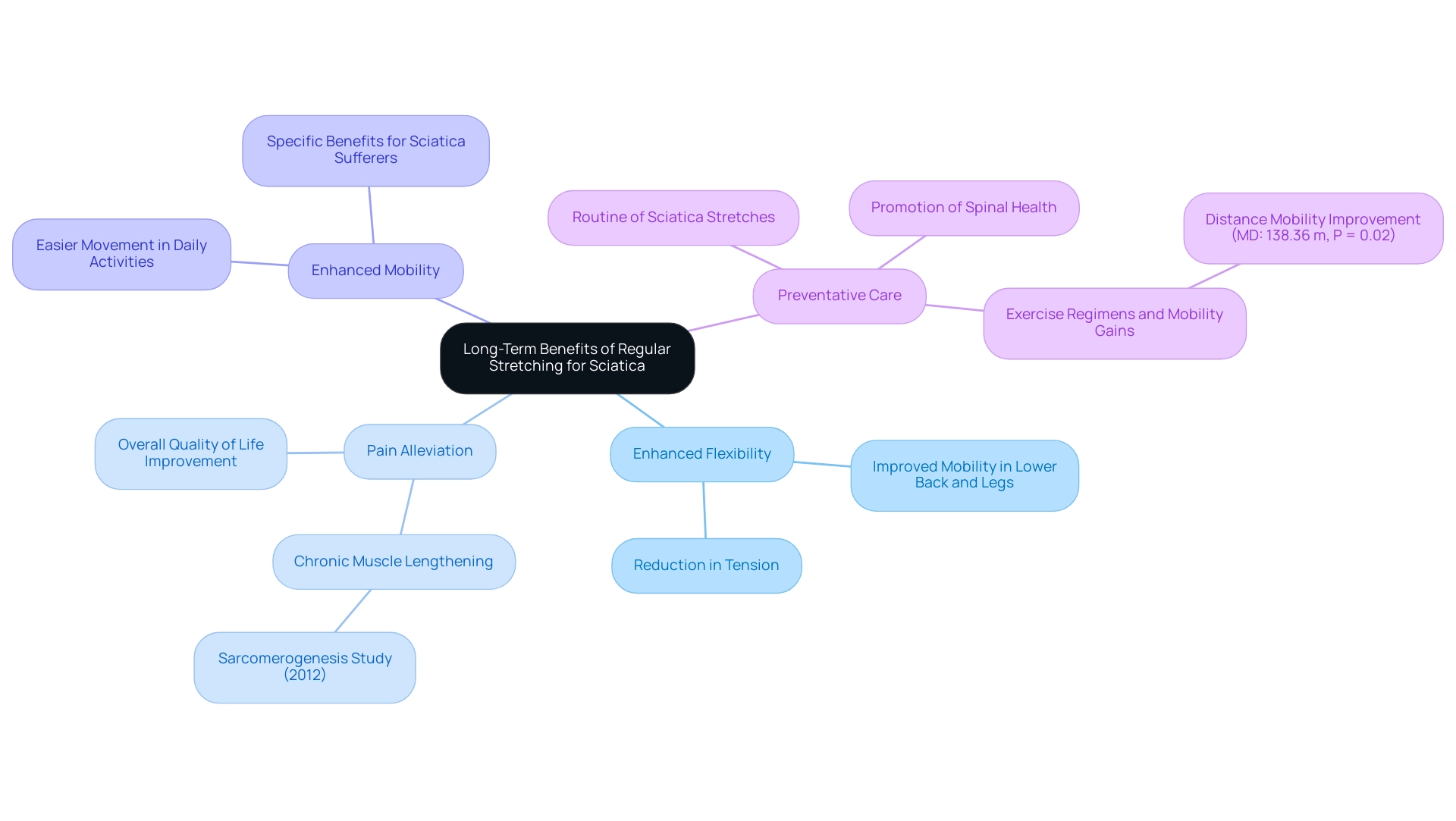
5. When to Consult a Healthcare Professional for Sciatica
Individuals experiencing nerve pain should seek consultation from a healthcare professional under the following circumstances:
-
Persistent Pain: If pain continues despite efforts such as stretching and self-care, a professional evaluation is essential. While lower back pain often resolves within six weeks, persistent symptoms beyond this timeframe may indicate a more serious underlying condition that warrants immediate attention.
-
Severe Symptoms: Symptoms that include loss of bladder or bowel control, severe weakness, or numbness in the legs warrant immediate medical attention. As noted by experts,
1> Sciatica usually affects only one leg at a time <
, emphasizing the need for careful monitoring of symptoms.
-
Impaired Mobility: If there is significant difficulty walking, it is crucial to consult a healthcare provider to assess the underlying issues. Such impairments may signal a more serious condition that requires intervention.
-
Unexpected Changes: Any sudden changes in existing symptoms or the emergence of new symptoms should prompt a professional consultation. This is necessary to rule out serious complications such as herniated discs or spinal stenosis, as evidenced in the case of J Vreuls, who experienced prolonged discomfort due to a delayed diagnosis and ultimately required targeted treatment for his herniated disc.
Conclusion
Understanding sciatica and its complexities is crucial for effective management and relief. The article highlights the various causes of sciatica, including:
- Herniated discs
- Spinal stenosis
Alongside the common symptoms such as:
Recognizing these factors is the first step toward addressing the condition through targeted strategies, particularly stretching exercises that can provide immediate relief and improve mobility.
Incorporating essential stretches into a daily routine not only aids in alleviating discomfort but also promotes long-term benefits such as improved flexibility and reduced pain. The safety guidelines outlined emphasize the importance of:
- A proper warm-up
- Listening to one’s body
- Consulting professionals when needed
These practices are vital for preventing further injury and ensuring that stretching remains an effective tool in managing sciatica.
Ultimately, while sciatica can present significant challenges, the combination of informed stretching practices and timely professional guidance can enhance quality of life and foster long-term relief. By taking proactive steps and adhering to safe practices, individuals can better navigate their path toward recovery and improved well-being.
